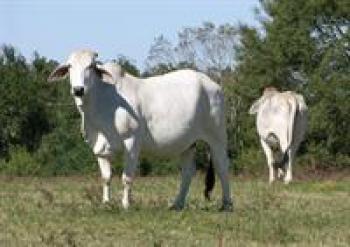Decade-long project improves characteristics of Brahman cattle
The LSU AgCenter and the American Brahman Breeders Association started the national carcass evaluation project in 2001 as a way to evaluate marbling, tenderness and yield in the Brahman breed.
LSU AgCenter animal scientist Matt Garcia, the lead researcher on the project, said producers need this carcass information to show that the improvements they desire are actually being accomplished.
“What we’re doing is bringing steers to the feedlot and testing them for the desired traits at harvest,” Garcia said.
A total of 595 steers went through the carcass evaluation program from 2004 to 2013, and were evaluated for initial weight, feedlot average daily gain and harvest weight.
Garcia said research that began at the AgCenter to evaluate the Brahman-influenced cattle for tenderness has developed into a national program.
The study began with longtime AgCenter researcher Don Franke looking at the meat quality of purebred Brahman steers and finding that genetic markers could be used to identify those that will produce acceptable carcasses based on quality grade and tenderness.
Garcia said until this time, Brahman producers were losing money in the sale ring because buyers had stereotyped the “humped” cattle as less tender and therefore bringing a lower price.
“It’s been known that Braham cattle, even with all of their positives, like being heat-adapted, parasite-adapted and long-lived--they did great here,” he said. “The problem was they wouldn’t grade high enough to be sold as high-quality beef.”
What the researchers are now looking at are carcass weight, dressing percent, ribeye area, marbling score, quality grade, yield grade and tenderness score, Gracia said.
“The analyses of these carcass traits have revealed an improvement in the vast majority of the traits evaluated,” he said.
The 595 steers evaluated each year were delivered to the feedlot in December and evaluated through July, before they were harvested at an average weight of about 1,400 pounds.
In addition to Louisiana producers, cattle producers from Alabama, Texas and even Mexico now participate in the program, he said.
“Up until this year, I think we were the only university participating in terms of sending cattle,” Garcia said. “Now Texas A&M is on board and will be sending cattle this year to help expand the program.”
Garcia said one of the findings of his study is that the average daily gain and harvest weights have increased each of the 10 years. This was while the initial test weights were trending downward, which indicates the cattle were entering the carcass evaluation program at lighter weights in recent years.
“Our analyses of carcass quality traits showed a per–year increase in performance for all of the traits evaluated, with the exception of the tenderness test,” he said.
Garcia said he feels the program will expand in the next 10 years.
“I believe you’re going to see a lot of people putting their steers into the program,” he said. “I think a lot of people were hesitant in the past because they weren’t sure of the outcome.”
Garcia said he believes in the near future there will be an increase in the amount of Brahmans grading choice, and he expects tenderness to become more comparable with other breeds.
For more information on the Louisiana beef and forage industry, check out the fall 2014 issue of Louisiana Agriculture Magazine.
- Log in to post comments

